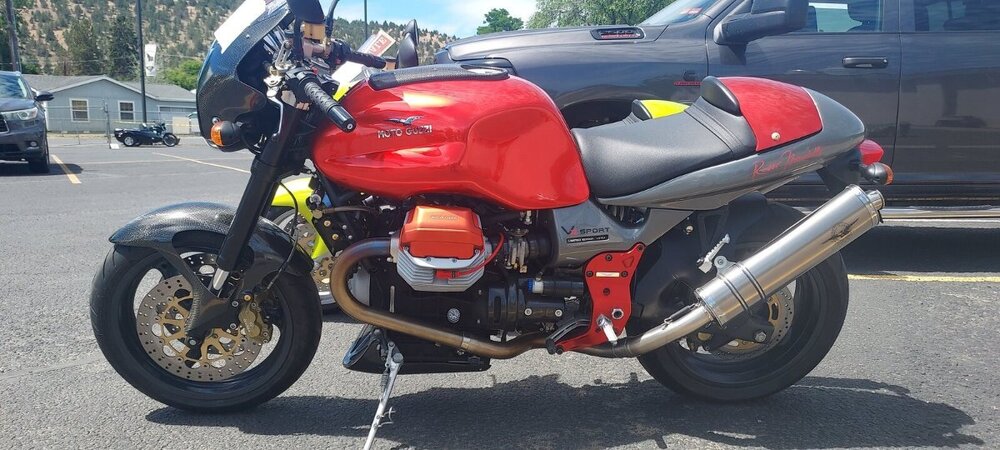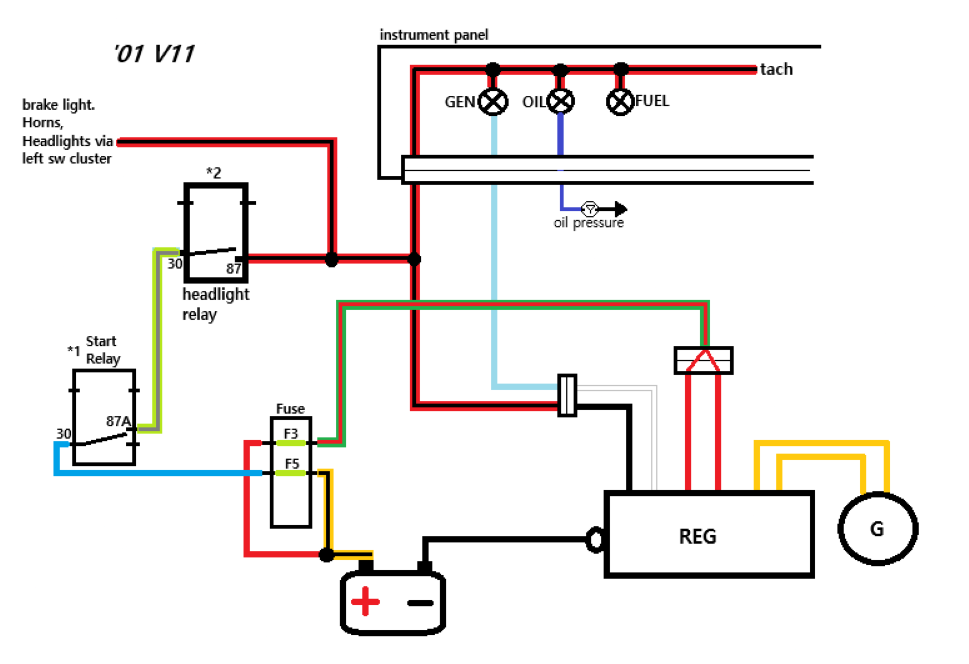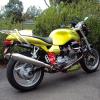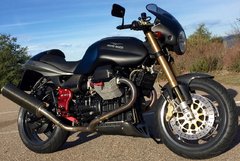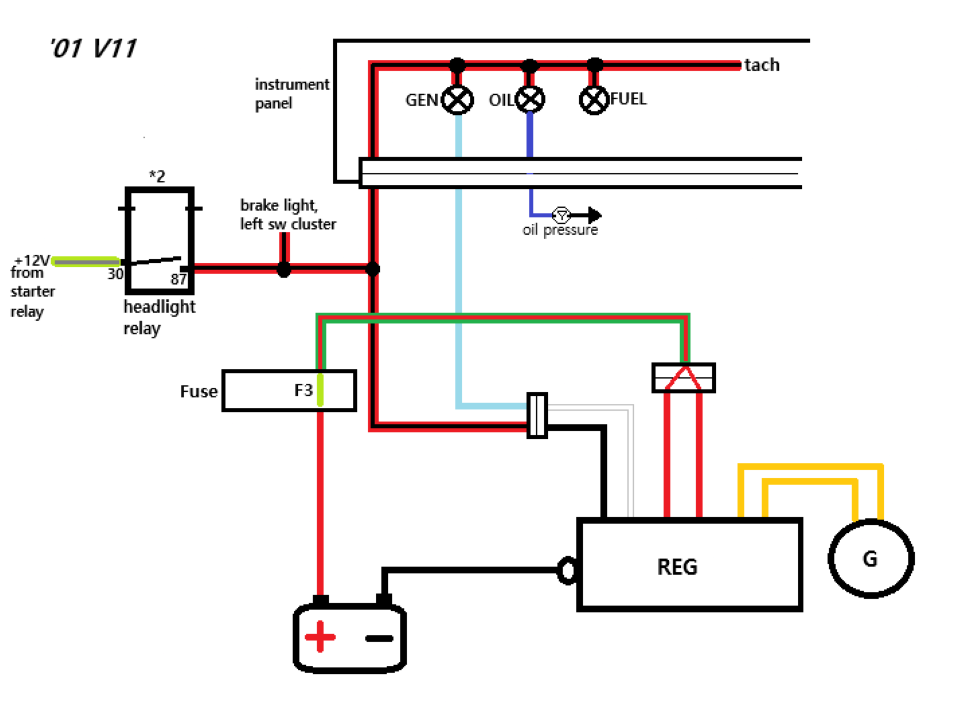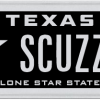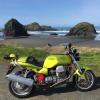Leaderboard
Popular Content
Showing content with the highest reputation on 09/23/2025 in Posts
-
Just did this and the oil light fires up! There was a bit of corrosion in this connection, and I hit it with some Deoxit and wiped it down.5 points
-
4 points
-
3 points
-
Just did this with key on/engine off, and the battery light did indeed light up. Are we making some progress here? I hope so!3 points
-
3 points
-
My Ducati 1000ss DS, 1000cc air cooled fuel injected engine with about the same specific output of a Norge, recommended oil 10W-40. My Guzzi 1100 2 valve same as Norge engine basically ran for 10 years on M1 0W-40. Not many road engines are going to "blow up" because of the oil you use or the grade. But when you pull it down for a rebuild it can make the difference between whether or not you have a simple and cost effective re ring and new big end shells and valve guides or the total every wear part needs to be replaced and it's a part out job now expense wise. Then there is giving away performance and fuel economy aspect. Me, I just like to run what I know myself is the best oil for my specific needs and eliminate the corporate "less than ideal but cover all bases" approach no matter how obscure and ridiculous. Phil2 points
-
2 points
-
With the trickle charger connected to the battery, test the voltage across the battery terminals (charge voltage). Most common "trickle chargers" will be below Odyssey's 13.2v minimum threshold.2 points
-
2 points
-
Did not start it up. I will do this tomorrow morning and report back. Need to get some better terminal connections for the jumper wire if I am going to fire up the motor.2 points
-
No battery light with a jumper wire from battery + attached, key on engine off......2 points
-
Haven't bread each response, on the road- but *any* wire circuit should show very near zero ohms. If the lamps are in this circuit, maybe ok. If not, a serious fault.2 points
-
Coming home from the Spine Raid XXI I like to think of the wife and Susan calling me home. It makes the last 500 miles of the trip easier.2 points
-
I think I have an extra set of frame plates and valve covers if you want to take them to a powder-coater or painter. I could sell them to you, or you could give me back your take-offs after you swap in the painted ones. We are only 100 miles apart.2 points
-
I so love Susan Tedeschi. Don't tell Derek Trucks. Or my wife. Great web find: Susan in 2001. No wonder Derek said, "Gotta marry that girl" . . .2 points
-
2 points
-
Let's talk batteries, @Sam P. Did you replace the "destroyed Odyssey" with another Odyssey, or something else? A voltage loss from 13.0 to 12.7 in an hour is not a good sign for an Odyssey. There are specific parameters to "condition" the Odyssey that may help contribute to a solution. "trickle chargers"/ "tender" are known to be damaging to the Odyssey battery unless the voltage is adequate, yet will not "charge" the Odyssey with sufficient amperage (at least 6 amps).2 points
-
Absolutely ! SamP forgive our zeal but we want you to get this fixed and operating correctly. Moto Guzzi will make you an electrical tch whether you want it or not !2 points
-
I think: cigars all around. I cannot imagine another online community with this much enthusiasm dedicated to helping another member solve a problem.2 points
-
Thanks Phil...very good and educational explanation...I'll try experimenting at the next oil changes on the Norge/Griso/Scura with a viscosity spread of 30...if I can perceive any improvement in performance, "feeling" and / or mileage that would be a bonus.1 point
-
The red/green wire that had a wire nut at the end , did you connect it to anything ?1 point
-
1 point
-
The bulb is in this circuit. IDK what r value is for the bulb , BUT i am happy.1 point
-
Did you start it to see if it charges with the jumper wire to the black wire of the regulator? Next, I would jumper the other side of the connector (battery voltage to the white wire and the connector rotated to connect the black --> red/black. I don't think the light will come on at all in that configuration. Looking for the charging voltage to come up while running above idle. . .1 point
-
Good call on getting the approved charger. Odyssey states that float voltage below 13.2v will shorten battery life. What is your trickle charger's voltage?1 point
-
I replaced the blistered and bloated Odyssey last month with a new one, just before I started this thread. I've skimmed through your Odyssey Battery Conditioning thread (20+ pages!) and have ordered what I believe is an appropriate charger.(Battery Minder 128CEC2, which I believe replaces the older 12248 model). Will condition my battery asap, but I assume I can continue to troubleshoot my charging issues in the meantime. I am still keeping the battery on my trickle charger, which keeps the volts at 13-13.4, and I hope this isn't hurting the battery.1 point
-
How about running a jumper wire from the battery positive to the black wire into the regulator (turn the connector 90 degrees to leave the white->blue connected). KOEO: battery light on? Start up and normal charging at some rpm with no 4000 rpm light?1 point
-
for the Ballabio lh grey plate this turned up... https://ad.fowlersparts.co.uk/parts/view/GU014158911 point
-
I normally web search the part number. For example this turned up for GU01415880 https://cadrecycle.com/product/lh-rear-fork-plate-cafe-sport/ I'm not sure how many models had grey or how many different greys they made. Valve covers. I believe the color you want came standard on the NC and the RC. Also looks like RM but I can't be sure. That's potentially a few p/n's to look for.1 point
-
Looking at this simplified diagram , you should be able to disconnect the two wire connector (blue wire & red/black wires) and apply 12v and - to these two wires and the gen light turn on. This will test the bulb and wiring circuit.1 point
-
good suggestion, I will pour some Evan Williams and make some changes1 point
-
Nicely simplified schematic. Just a note, that the red/black output from "Headlight" Relay (#2) does supply the brake light (also horns), but not the entire left switch cluster (i.e.: not the turn signals). Perhaps Fuse #5 (F5) should be indicated ahead of the Starter Relay. Turn signals are Fuse #7 (F7)1 point
-
Here is the @Kiwi_Roy rendition ( hosted on @Weegie's dropbox ): https://www.dropbox.com/scl/fo/no8adkie1sl6frnc2qmm8/ALzrUXsngCqMRtfMR1cXedE?dl=0&e=1&preview=Guzzi+Wiring+-+Simple.pdf&rlkey=8x5byzd4ux3107610i22ig5v6&st=3xbx7rbu1 point
-
No concrete reccomendation, I'm afraid. What @gstallons was getting at here was to check for continuity from where the power that makes the warning light go on, the output of the lighting relay, to the wire after the warning light that goes into the regulator, where it is switched to earth by the regulator when the charging system isn't working. As far as I can tell, you did measure between the correct points, and saw 15 Ohms. There is a light bulb in that circuit, the warning lamp, so the resistance wont be zero. Apart from that, the wires themselves will have a resistance, albeit very low. Whatever, maybe the 15 Ohms are ok. Without knowing the wattage of the light bulb, it's guesswork. Thinking about it, if one assumes slightly ratty connections, and takes a couple of Ohm away from the light bulb for that, the wattage for the light starts heading towards 1.5 Watt, which is plausible, I think. EDIT: the maths were wrong. I just went back an looked at it again, and realise that in fact there is a total of something like 9.6 Watt being generated. That is, I reckon, actually too much for a warning lamp, so probably the lamp itself plus some ratty connections. I still suspect that there are two perhaps unrelated issues here, i.e. the weird business that the charge warning lamp only comes on at high revs, not at key on engine off, and the indications (never more than about 12,3 Volt at the battery) that the system is never charging, not only not charging at high revs. As @docc mentioned further up, the fact that the oil light doesn't go on at key on engine off is also weird. The oil pressure switch is a simple switch that opens when the oil pressure rises. Therefore, it also must light when the ignition is turned on, until the motor is running. As far as that goes, maybe there is indeed a bad connection in the dash somewhere. Both of those lights get their power from the same source, via connector #8 on the wiring diagram which is most likely the 12 pole Amp connector you mentioned further up. Without saying it is the only way to go, I would personally want to know that those warning lights are functioning the way they are intended, and would focus on that first. The reason being, if the charge warning light is doing unexpected stuff, it may be masking the charging problem (but not causing it!). On the other hand, if the supply to that light is not solid, that may affect the regulator. I would expect the regulator to overcharge in that case, but don't know for sure if it really would. EDIT: forgot to mention... The next thing I would do at this point is measure the resistance (Ohm) from the input for the blue wire on the regulator (not the wire itself, the connector on the regulator) to ground. Firstly key on, engine off, then at various motor speeds. It should be open (almost zero Ohms) without the engine running, and closed (very high resistance) with the engine running. What happens there when the engine hits the engine speed at which the light has been coming on would also be interesting.1 point
-
" recommendation for next steps " . . . For starters, I am going back over all of the outcomes. Like @audiomick, I suspect a high resistance problem (bad/corroded connector) in the mix. I suspect this is in the "voltage reference"/warning light wiring. The oil light issue may be a clue. @Sam P, can you pull the connector from the oil switch and ground it (KOEO) to see if the oil light illuminates?1 point
-
I have said this once before. I think EVERY V11 has their own wiring harness and ign. key.1 point
-
The oil light , gen light and low fuel light are connected to the + terminal of the tach (I assume it works ?) , the front brake light switch (does it work?) , turn signals (do they work?) and rear brake light switch(does it work?)1 point
-
You've mixed up terms there. You're not measuring current, that is the amount of electricity that is flowing at a point in time. You're measuring voltage. That's the "electrical pressure", correct term "electrical potential", that is present at that point in the circuit. You're quite right to consider whether the volts are being pushed in from the regulator or are coming from the battery. That is the correct question. The fact that the voltage is not changing at any revs indicates that the regulator is not "pushing volts into the battery". If it were, as has been mentioned further up, the voltage at that point should go up to around 14V at higher revs. It isn't, so the volts are getting lost in the regulator (it's malfunctioning) or not getting from the regulator to the battery (bad connection).1 point
-
@Sam P I was away over the weekend. Reading over what has been posted in the last couple of days, it seems you don't always know why you are measuring what people suggest. I made rough and simple sketch of the charging circuit, in the hope that it will confuse you even further maybe help a bit. Hope that helps you understand what is going on.1 point
-
For the fools, including myself, who follow the owner's manual, but occasionally check for updates out there, and I include looking at cars as well, not just motorcycles. So far at 60K miles of use, the Norge hasn't blown up yet due to improper oil usage! Based on official documentation and owner discussions, Moto Guzzi has not changed the oil recommendation for the 2008 Norge. The manufacturer's specification has remained a high-quality 10W-60 synthetic motor oil. The original recommendation At launch, the official factory recommendation for the Norge was Agip 4T full synthetic 10W-60 oil. The reasons for this specific viscosity include: Air/oil-cooled engine: The air-cooled V-twin engines run hotter than liquid-cooled counterparts, and the 10W-60 weight helps the oil maintain its viscosity under high thermal stress. Higher film strength: The engine has specific characteristics, such as a dry clutch, that necessitate a high film strength oil for longevity. Updated guidance While the fundamental recommendation has not changed, the brand of oil has. Since the original Agip oil is now more difficult to find, Moto Guzzi recommends the equivalent Castrol Edge 10W-60 synthetic for its modern big-block engines. Considerations for older models Some owners of older Norge models have noticed changes in oil API (American Petroleum Institute) ratings over time. Specifically, some older formulations of Agip oil had a more desirable SG rating. Because newer formulations may have different ratings, many owners prioritize finding a quality 10W-60 synthetic oil with a higher concentration of zinc and phosphorus to protect the valve train. However, the 10W-60 viscosity remains the most critical specification.1 point
-
Oh crap, Relay 2 was not installed, sorry about that. Will reinstall the relay first thing tomorrow, and redo the voltage tests on the blue wire, as well as the red/black wire from the harness. Stay tuned and thank you again.1 point
-
Victory! The first row of bikes to show up were all Guzzis! Then later some other Italian brands showed up. Sent from my iPhone using Tapatalk1 point




